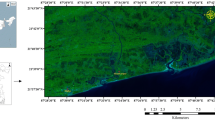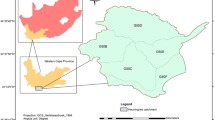Abstract
The Central Godavari delta is located along the Bay of Bengal Coast, Andhra Pradesh, India, and is drained by Pikaleru, Kunavaram and Vasalatippa drains. There is no groundwater pumping for agriculture as wells as for domestic purpose due to the brackish nature of the groundwater at shallow depths. The groundwater table depths vary from 0.8 to 3.4 m and in the Ravva Onshore wells, 4.5 to 13.3 m. Electrical Resistivity Tomography (ERT) surveys were carried out at several locations in the delta to delineate the aquifer geometry and to identify saline water aquifer zones. Groundwater samples collected and analyzed for major ions for assessing the saline water intrusion and to identify the salinity origin in the delta region. The results derived from ERT indicated low resistivity values in the area, which can be attributed to the existence of thick marine clays from ground surface to 12–15 m below ground level near the coast and high resistivity values are due to the presence of coarse sand with freshwater away from the coast. The resistivity values similar to saline water <0.01 Ω m is attributed to the mixing of the saline water along surface water drains. In the Ravva Onshore Terminal low resistivity values indicated up coning of saline water and mixing of saline water from Pikaleru drain. The SO −24 /Cl−and Na+2/Cl−ratios did not indicate saline water intrusion and the salinity is due to marine palaeosalinity, dilution of marine clays and dissolution of evaporites.














Similar content being viewed by others
References
Abdollahi-Nasab A, Boufadel MC, Li HL, Weaver JW (2010) Saltwater flushing by freshwater in a laboratory beach. J Hydrol 386(1–4):1–12
Abu-Zeid N, Bianchini G, Santarato G, Vaccaro C (2004) Geochemical characterization and geophysical mapping of landfill leachates: the Marozzo canal case study (NE Italy). Environ Geol 45(4):439–447
Alpar B (2009) Vulnerability of Turkish coasts to accelerated sea-level rise. Geomorphology 107(1–2):58–63
APHA (2005) Standard methods for the examination of water and wastewater, 21st edn. American Public Health Association, Washington, DC
Barker R (1981) The offset system of electrical resistivity sounding and its use with a multicore cable. Geophys Prospect 29:128–143
Barker R, Moore J (1998) The application of time-lapse electrical tomography in groundwater studies. Lead Edge 17:1454–1458
Bentor YK (1961) Some geochemical aspects of the Dead Sea and the question of its fate. Cosm Acta 25:239–260
Bernstone C, Dahlin T (1997) DC resistivity mapping of old landfills: two case studies. Eur J Environ Eng Geophys 2:121–136
Bisdorf RJ, and Lucius JE (1999) Mapping the Norman, Oklahoma, landfill contaminant plume using electrical geophysics. Water-Resources Investigations Report 99-4018C. U.S. Geological Survey
Bobba AG (2002) Numerical modeling of salt-water intrusion due to human activities and sea-level change in the Godavari Delta, India. Hydrol Sci J 47:S67–S80
Breen KJ, Angelo CG, Masters, RoW and Sedam AC (1985) Chemical and isotopic characteristics of brines from three oil and gas producing sandstones in eastern Ohio, with application to the geochemical tracing of brine source. U.S. Geological Survey, Water Res. Invest. Report 84-4314, pp. 58
Bugg SF, Lloyd JW (1976) A study of freshwater lens configuration in the Cayman Islands using resistivity methods. Q J Eng Geol 9:291–302. doi:10.1144/GSL.QJEG.1976.009.04.02
Carreira PM, Marques JM, Pina A, Gomes AM, Galego Fernandes PA, Santos FM (2010) Groundwater assessment at Santiago Island (Cabo Verde): a multidisciplinary approach to a recurring source of water supply. Water Resour Manag 24(6):1139–1159
CGWB (1999) Groundwater Resources and Development Prospects in East Godavari District, Andhra Pradesh. Ministry of Water Resources, Government of India. Unpublished Report, pp. 210
Chidambaram S, Kumar GS, Prasanna MV, Peter AJ, Ramanthan AL, Srinivasamoorthy (2008) A study on the hydrogeology and hydrogeochemistry of groundwater from different depths in a coastal aquifer: Annamalai Nagar, Tamilnadu, India. Environ Geol 57(1):59–73
Choudhury K, Saha DK, Chakraborty P (2001) Geophysical study for saline water intrusion in a coastal alluvial terrain. J Geophys 46:189–200. doi:10.1016/S0926-9851(01)00038-6
Custodio E (2010) Coastal aquifers of Europe: an overview. Hydrogeol J 18(1):269–280
Dahlin T (1996) 2D resistivity surveying for environmental and engineering applications. First Break 14:275–284
Danielopol DL, Griebler C, Gunatilaka A, Notenboom J (2003) Present state and future prospects for groundwater ecosystems. Environ Conserv 30(2):104–130
De Breuk W, De Moor G (1969) The water table aquifer in the eastern coastal area of Belgium. Bull Assoc Sci Hydro 14:137–155
Dey A, Morrison HF (1979) Resistivity modelling for arbitrary shaped two-dimensional structures. Geophys Prospect 27:1020–1036
Edwards LS (1977) A modified pseudosection for resistivity and induced-polarization. Geophysics 42:1020–1036
Falgas E, Ledo J, Marcuello A, Queralt P (2009) Monitoring freshwater–seawater interface dynamics with audiomagnetotelluric data. Near Surf Geophys 7(5–6):391–399
Frohlich RK, Urish DW, Fuller J, Reilly MO (1994) Use of geoelectrical method in groundwater pollution surveys in a coastal environment. J Appl Geophys 32:139–154
Ginsberg A, Levanton A (1976) Determination of saltwater interface by electrical resistivity sounding. Hydrolog Sci Bull 21:561–568
Giordana G, Montginoul M (2006) Policy instruments to fight against seawater intrusion in coastal aquifers: an overview. Vie Et Milieu-Life And Environment 56(4):287–294
Gossling S (2001) The consequences of tourism for sustainable water use on a tropical island: Zanzibar, Tanzania. J Environ Manag 61(2):179–191
Griffiths, Barker RD (1993) Two dimensional imaging modeling in areas of complex geology. J Appl Geophys 20:211–226
Griffiths DH, Turnbull J, Olayinka AI (1990) Two dimensional resistivity mapping with a computer controlled array. First Break 8:121–129
GSI (2006) Geology and mineral resources of Andhra Pradesh. GSI Miscellaneous Publication No.30 Part VII, 2nd Revised Edition, p. 91
Gurunadha Rao VVS, Thamma Rao G, Surinaidu L, Rajesh R, Mahesh J (2011) Geophysical and geochemical approach for seawater intrusion assessment in the Godavari Delta Basin, A.P., India. Water Air Soil Pollut 217:503–514. doi:10.1007/s11270-010-0604-9
Hem JD (1985) Study and interpretation of the chemical characters of the natural water U.S. Geological Survey Water Paper 2254, pp. 264
Hidalgo MC, Cruz-Sanjulian J (2001) Groundwater composition, hydrochemical evolution and mass transfer in a regional detrital aquifer (Baza basin, southern Spain). Appl Geochem 16(7–8):745–758
Hodlur GK, Dhakate R, Sirisha T, Panaskar DB (2010) Resolution of freshwater and saline water aquifers by composite geophysical data analysis methods. Hydrol Sci J 55(3):414–434
Howard KWF, Mullings E (1996) Hydrochemical analysis of groundwater-flow and saline incursion in the Clarendon Basin, Jamaica. Ground Water 34(5):801–810
Karanath KR (1987) Quality of ground water. In: Karnath KR (ed) Ground water assessment development and management. Tata McGraw Hill, New Delhi, pp 217–275
Khair K, Aker N, Haddad F, Jurdi M, Hachach A (1994) The environmental impacts of humans on groundwater in Lebanon. Water Air Soil Pollut 78(1–2):37–49
Kouzana L, Benassi R, Ben Mammou A, Felfoul MS (2010) Geophysical and hydrochemical study of the seawater intrusion in Mediterranean semi arid zones. Case of the Korba coastal aquifer (Cap-Bon, Tunisia). J Afr Earth Sci 58(2):242–254
Lambrakis N (2006) Multicomponent heterovalent chromatography in aquifers. Modelling salinization and freshening phenomena in field conditions. J Hydrol 323(1–4):230–243
Loke MH (1994) The inversion of two dimensional resistivity data. Unpublished PhD thesis, Univ. of Birmingham
Maillet R (1947) The fundamental equations of electrical prospecting. Geophysics 12(4):529–556
Mercado (1985) The use of hydrogeochemical patterns in carbonate sand and sandstone aquifers to identify intrusion and flushing of saline water. Groundwater 23(1985):635–645
Mondal NC, Singh VP, Singh VS, Saxena VK (2010) Determining the interaction between groundwater and saline water through groundwater major ions chemistry. J Hydrol 388(2010):100–111
Mondal NC, Singh VP, Singh S, Singh VS (2011) Hydrochemical characteristic of coastal aquifer from Tuticorin, Tamil Nadu, India. Environ Monit Assess 175(1–4):531–550
Nowroozi AA, Stephen BH, Henderson P (1999) Saltwater intrusion into the freshwater aquifer in the eastern shore of Virginia: a reconnaissance electrical resistivity survey. J Appl Geophys 42:1–22. doi:10.1016/s0926-9851(99)00004-x
Parkhomenko EI (1967) Electrical properties of rocks. (Translated from Russian and edited by Keller GV). Plenum Press, New York
Rengamannar V, Pradhan PK (1991) Geomorphology and evolution of Godavari delta. Mem Geol Soc India 22:51–56
Respond H (1990) Geoelektrische Untersuchungen zur Bestimmung der azwasserrSusswasser-Grenze im Gebiet zwishen Cuxhaven und Stade. Geol Jahrb C 56:3–37
Roy A, Apparao A (1971) Depth of investigation in direct current methods. Geophysics 36:943–959
Sabet MA (1975) Vertical electrical resistivity sounding locate groundwater resources: a feasibility study. Virginia Polytechnical Institute. Water Resour Bull 73:63
Sanford WE, Pope JP (2010) Current challenges using models to forecast seawater intrusion: lessons from the Eastern Shore of Virginia, USA. Hydrogeol J 18(1):73–93
Sarwade DV, Nandakumar MV, Kesari MP, Mondal NC, Singh VS, Singh B (2007) Evaluation of seawater ingress into an Indian Attoll. Environ Geol 52(2):1475–1483
Saxena VK, Singh VS, Mondal NC, Jain SC (2003) Use of chemical parameters to delineation fresh ground water resources in Potharlanka Island, India. Environ Geol 44(5):516–521
Saxena VK, Mondal NC, Singh VS (2004) Identification of seawater ingress using Sr and B in Krishna delta. Curr Sci 86(4):586–590
Sharma PV (1997) Environmental and engineering geophysics. Cambridge University Press, Cambridge, p 475
Sharma VVJ, Rao B (1962) Variation of electrical resistivity of river sands, calcite and quartz powders with water content. Geophysics 17(4)
Silvester PP, Ferrari RL (1990) Finite elements for electrical engineers, 2nd edn. Cambridge University Press, Cambridge
Somay MA, Gemici U (2009) Assessment of the salinization process at the coastal area with hydrogeochemical tools and Geographical Information Systems (GIS): Selçuk Plain, Izmir, Turkey. Water Air Soil Pollut 201:55–74
Subba Rao N (2006) Seasonal variation of groundwater India. Environ Geol 49:413–429
Trefry MG, Svensson TJA, Davis GB (2007) Hypoaigic influences on groundwater flux to a seasonally saline river. J Hydrol 335(3–4):330–353
Urish DW, Frohlich RK (1990) Surface electrical resistivity in coastal groundwater exploration. Geoexploration 26:267–289
Valyashko MG, Lavrova AN (1976) Some new possibilities of using bromine–chlorine relations for studying the conditions of formation of evaporate deposits (In Russian). In: Vinogradov AP (ed) The bromium in brines as a geochemical indicator of the genesis of salt deposits. Moscow Univ Press, Moscow, pp 343–353
Van Dam JC, Meulenkamp JJ (1967) Some results of the geo-electrical resistivity method in groundwater investigations in The Netherlands. Geophys Prospect 15(1):92–115
Vengosh A, Ben-Zvi A (1994) Formation of a salt plume in the coastal plain aquifer of Israel: the Be’er Toviyya region. J Hydrol 160:21–52
Vengosh A, Spivack AJ, Artzi Y, Ayalon A (1999) Geochemical and boron, strontium, and oxygen isotopic constraints on the origin of the salinity in groundwater from the Mediterranean coast of Israel. Water Resour Res 35(6):1877–1894
Vengosh A, Kloppmann W, Marei A, Livshitz Y, Gutierrez A, Banna M, Guerrot C, Pankratov I, Raanan H (2005) Sources of salinity and boron in the Gaza strip: natural contaminant flow in the southern Mediterranean coastal aquifer. Water Resour Res 41(W01013):1–19
Warner DL (1969) Preliminary field studies using earth resistivity measurements for delineating zones of contaminated groundwater. Groundwater 7:9–16
Zohdy AAR (1969) The use of Schlumberger and equatorial soundings on ground water investigations near El Paso, TX. Geophysics 34:713–728
Acknowledgments
The authors are thankful to the Director, NGRI, Hyderabad, for his encouragement to publish this paper. The authors also express their sincere thanks to the Cairn India Ltd for sponsoring the project to the NGRI
Author information
Authors and Affiliations
Corresponding author
Rights and permissions
About this article
Cite this article
L.S., N., V.V.S., G.R., G., T.R. et al. An integrated approach to investigate saline water intrusion and to identify the salinity sources in the Central Godavari delta, Andhra Pradesh, India. Arab J Geosci 6, 3709–3724 (2013). https://doi.org/10.1007/s12517-012-0634-2
Received:
Accepted:
Published:
Issue Date:
DOI: https://doi.org/10.1007/s12517-012-0634-2




